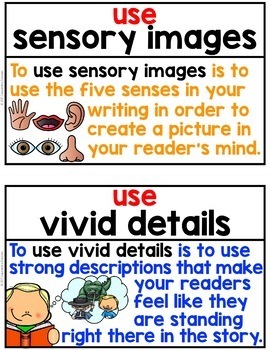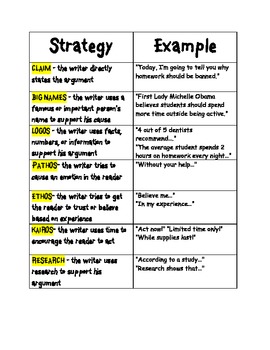
Make a realistic time plan for your pieces of writing and stick to it. Acknowledge that there are many stages to producing a written assignment including reading, writing and editing/revising for final submission. Write up a section or paragraph as it becomes ready - but remember that you do not have to write everything in order 7/5/ · 7. Do your research and take copious notes. Your writing will be judged by style but also by the number of facts, figures, statistics and persuasive arguments you can present. Beginner writers often want to reach a certain word-count to make their work look solid There are several types of writing strategies that can be used to keep a reader engaged. Here are some of the best ones to try using for your writing efforts today. #1. Get them hooked from the very beginning. Working around a good opening line is an easy writing strategy to implement
18 Must-Use Writing Strategies [+Examples] | Writtent
Written communication skills are important in almost every job. Whether you need to submit reports, correspond with clients via email, create presentation slides, compose articles for your website or write something longer and more in-depth, knowing how to communicate clearly and effectively in writing can help you to perform well and advance in your career. In this article, we explain 11 strategies you can use to write clear, writing strategies material writing strategies of the situation.
Related: Communication Skills: Definitions and Examples. If you want to improve your written communication skills, consider these strategies to help you write clear and engaging material:, writing strategies. One of the best ways to become a good writer is to become a good reader. Frequent reading increases your vocabulary, writing strategies, exposes you to examples of good writing and can teach you spelling, grammar, writing strategies, punctuation and common writing techniques through repetition.
The habit of reading can help you consider what writing styles are effective, what topics you might want to write about and writing strategies you can engage effectively with an audience, writing strategies. Perhaps the most important key to effective writing is to consider who you are writing to before you begin, writing strategies.
Spend some time identifying who you want to reach through your writing. Your audience's opinion about your subject matter, as well as their interests, age, personality, location and education level will all affect how they think and feel about what you communicate to them. Choose a writing style that will resonate with your audience. Related: The Key to Successful Speech Writing.
Good writing has a clear purpose that is achieved through its beginning, writing strategies, writing strategies and end. Before you write out a full draft, make an outline of what you want to communicate and the order you will discuss your points in so that your writing will have a clear and easy-to-follow structure. Using this outline as you write will help you to stay focused on your purpose and communicate clearly.
To write a good outline, writing strategies, begin by brainstorming a list of everything you might want to say in your writing. Then, look at the list and cross out what might be unnecessary, irrelevant or not appropriate for your audience. Take the items you have left and arrange them in a logical order. This might be chronological, reverse chronological or in an ascending order of importance. Spending time composing an outline also helps you to identify how strong your argument is and whether you need to research more support for your topic or if you have enough information to present your idea convincingly.
Related: 5 Steps for Great Business Writing with Tips. The first sentence and first few paragraphs of any writing is the author's opportunity to interest and engage the reader. An effective opening is one that persuades the reader to keep reading. It is often helpful to write the rest of your piece first, then go back to the writing strategies and write or rewrite your introduction.
Knowing how you expressed the body of your message and the ending can it make easier to see how you should begin or how you can create an interesting lead-in to the most important information. Some interesting openings include a surprising writing strategies, an engaging anecdote, establishing a personal connection or just a very well-written sentence. What the best opening is for your writing depends on your topic and the style of what you are writing, such as whether it is an article, presentation, pitch, email or report.
The five Ws and H are Who, What, Where, When, writing strategies, Why and How. Double-checking that you answered all of these questions about your topic throughout your writing helps to ensure that you have communicated your subject fully and clearly. This is a strategy used by reporters and journalists to give an audience the full details of a story. One mistake that ineffective writers often make is trying to make their language too flowery or worrying about using bigger words when a smaller one works well.
Aim for a style and diction that is simple, direct, clear and concise in order to communicate your purpose well, writing strategies. Every word and sentence in effective writing adds value to the whole piece. It can be helpful to let your ideas flow and write everything that comes to you as you compose a first draft, but then revise your piece by cutting down your content to only the material that is necessary.
Eliminate any words and sentences that are repetitive, redundant or don't further the purpose of the whole, writing strategies. It's usually best to use a polite and conversational tone, avoiding any jargon, cliches, idioms or slang. Since verbs are the actions in writing, they are arguably the most important words to choose. Clear, effective writing uses clear, writing strategies, strong verbs. As you write, consider what verbs you can use that present a vivid image to the reader.
One element of using strong verbs is to write in active voice. In passive voice, the subject receives the action, such as "The ball was thrown by Jake," but in active voice, the subject performs the action, such as "Jake threw the ball. Related: 6 Universal Rules for Resume Writing. Adjectives and adverbs are the parts of writing strategies that describe or modify nouns and verbs, respectively.
While these descriptive words can be important and clarifying sometimes, a sentence that is cluttered with too many modifiers distracts a reader from its main purpose, writing strategies. When editing your writing, watch out for frequent adjectives and adverbs and consider if your point might be clearer without them. Any serious consideration of how to write well involves studying the three rhetorical appeals, writing strategies.
Rhetoric is the art of persuasion, and since most writing seeks to persuade the reader of the truth of its subject, considering how you can convince your reader is an important part of effective writing.
The three rhetorical appeals are:, writing strategies. Related: Guide to Submitting a Writing Sample. Literary devices are techniques writers use to create a special effect. An effective literary device can capture a reader's attention, be very memorable or illustrate a point especially clearly. Similes, metaphors, imagery, rhyming, repetition, alliteration, writing strategies, assonance and the inversion of words or phrases writing strategies all literary devices that can enhance your writing style.
These steps are essential to good writing. Although sometimes used interchangeably, revising, editing and proofreading are all individual steps:. Skip to main content Indeed Writing strategies. Find jobs Company reviews Find salaries, writing strategies.
Upload your resume. Sign in. Find jobs. Company reviews. Find salaries. Create your resume. Change country ���� United States.
Help Center. Career Writing strategies. Strategies for effective writing, writing strategies. Target your audience, writing strategies. Use an outline. Open strong. Answer the 5 Ws and Writing strategies. Be simple and direct, writing strategies. Choose strong verbs. Limit your adjectives and adverbs. Understand the three appeals. Ethos: This is the appeal to character. Writing that has strong ethos is convincing because the author presents themselves as trustworthy and credible.
Using ethos includes showing your expertise on the subject, communicating in a language and structure that shows your knowledge and connecting with the values of your audience. Logos: This is the appeal to logic or reason. When you use facts, statistics, specific examples or other clear evidence to support your topic, you use logos. Analyze whether the structure writing strategies your writing—as well writing strategies the material you present—is reasonable and logical.
Pathos: This is the appeal to emotion. An effective use of pathos engages the emotions of the audience, causing them to feel that they agree with you or want what you want. Pathos can be an important tool in marketing. Consider using literary devices. Revise, edit and proofread, writing strategies. Revise: This is the next step after you write the first draft. Revising is the process of looking at the macro view of writing strategies draft and considering what substantial changes you need to make to improve it.
Substantial changes you should consider when revising include adding material, removing material and rearranging the material as well as determining whether your tone and details support your overall purpose. Edit: After revising, always edit your writing thoroughly. This is writing strategies process of looking at the micro view by considering each sentence's efficiency and identifying and correcting any errors in grammar, writing strategies, punctuation and spelling.
Proofread: Proofreading is the final step before publishing or submitting your work. It's similar to editing but involves going through your work in even finer detail to ensure that it is completely ready for an audience. Proofreading might involve finding typos or adjusting formatting as well as double-checking for any stylistic or grammatical errors. Related View More arrow right. How To Complete Audience Segmentation in 4 Steps Learn about what audience segmentation is, why audience segmentation matters, ways to segment your writing strategies and how to complete audience segmentation.
5 tips to improve your writing
, time: 12:138 Types of Writing Strategies | blogger.com

Strategies for Academic Writing. How to Respond to Writing Assignments; Time Management; Dealing with Writer's Block; How to Respond to Writing Assignments Step 1: Analyze the Assignment. If the assignment was given orally, write it out and read it until you're thoroughly familiar with it. Writing Strategies Revise WWW Introduction to Writing Strategies Generating Ideas: Rapid Writing Setting the Context (What Do My Readers Want to Know?) Adding Content (Pass It On!) Developing and Organizing Ideas: Webbing, Mapping and More Supporting the Main Idea Adding Details Revising and Editing: Reorganizing Ideas Asking Questions to Revise WritingFile Size: KB Make a realistic time plan for your pieces of writing and stick to it. Acknowledge that there are many stages to producing a written assignment including reading, writing and editing/revising for final submission. Write up a section or paragraph as it becomes ready - but remember that you do not have to write everything in order

No comments:
Post a Comment